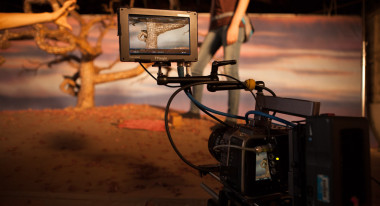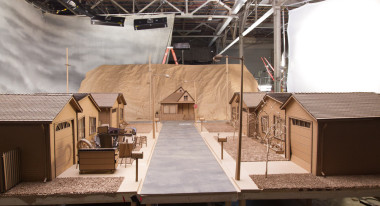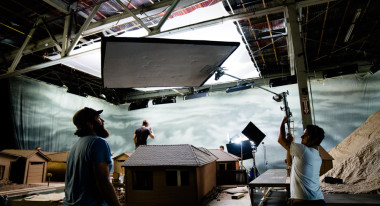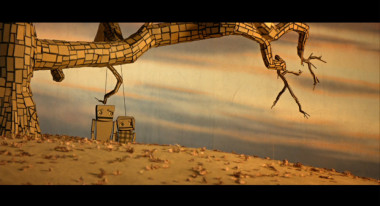 Back to selection
Back to selection
Joseph Oxford and Bradley Stonesifer Create a World in Cardboard for Me + Her

Director Joseph Oxford and cinematographer Bradley Stonesifer created an imaginary world using cardboard boxes and rubber bands for their animated short film Me + Her. A labor of love that evolved over four years, their work was rewarded when the film was accepted into Sundance’s Short Film program.
Oxford has worked in the industry since 2007 in a variety of roles, including production assistant and art director, but Me + Her is his first project as writer and director. Oxford first met cinematographer Stonesifer through a director friend, and they both worked on the film The Vicious Kind in 2008.
Oxford and Stonersifer talked to us about the development process and production of the movie:
Filmmaker: How did this project get started?
Oxford: It started at the end of 2008. I had a piece of cardboard and a rubber band and a pencil on my desk, and I tried to make a little makeshift guitar, and it didn’t work. But I drew some eyes on it and used the rubber band as the lips, and that was the first concept for the character design. And then I just built the world around that.
Stonesifer: From there it probably took two years of continued work to develop the script and also to do some test shooting. The process has evolved quite a bit since then, but the same rudimentary form is still there.
Oxford: By the time we finally shot this it was probably the forth iteration of the main characters, and we had done a lot of testing and redesigning and making things better and better. If I didn’t have deadlines I’m sure I would of made four more versions of each of them.
Filmmaker: What’s the movie about?
Oxford: At its core it’s essentially a “love and lost” story. I really like world building, so I just took that concept and put it in this different world and tried to work out how to make it original using the rules of this world.
Filmmaker: How are the characters animated?
Oxford: It’s all rod puppetry and animatronics, so it was all shot live action. The puppets have rods attached to the feet and the hands, and the puppeteers are operating them. Even from the early days I thought that having the rods visible in the film was kind of nice and made it feel more handmade — you could tell there was a personal touch. For close-up shots the faces were able to emote to a certain degree; the mouth could smile and frown, the eyebrows could shift from sad to mad, the eyes would blink and the puppeteers could control that from one controller.
Filmmaker: What was the shooting process? How did you direct this?
Oxford: I directed from behind the camera. I was not one of the puppeteers.
Because of the limitations of our puppets, it would have been impossible to shoot most of our scenes from start to finish. We had to break up the action quite a bit, and each shot would require repositioning of puppeteers and, many times, changing out puppet heads or body parts to suit the shot’s requirements.
There were three main kinds of puppet heads: a “wide shot head” that had no movement whatsoever, a “blinking head” that had controllable eyelids, and a “close up head” that could blink, the eyebrows could pivot individually from “mad” to “sad” and the lips could smile or frown.
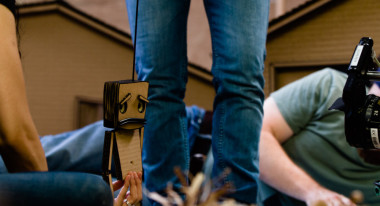
When we started hitting our stride, about halfway through production, I would talk to the puppeteers in the morning about the first shots for the day. I’d tell them what heads and body parts I thought it would require. I would explain to them how I thought the puppeteering could be executed, and if the shot would require complicated movements from the characters or the camera position would put considerable restrictions on where they could puppeteer from. They would practice off to the side while the grips and electrics set up the shot, then go to the set for a camera rehearsal, and then figure out what worked best for them and the scene.
The puppeteers brought elements of performance to the characters more than just running them through the motions. They were great.
Stonesifer: We treated the scenes as much like live action as we could. It took many rehearsals and improvising to achieve what Joey had intended. Our [uppeteers are great artists and collaborators. They brought emotion out of inanimate objects with their subtle moves and nuances.
Filmmaker: How many sets did you build?
Stonesifer: There’s a few different setups in each one, and there’s from six to ten scenes.
Filmmaker: What was the actual production process?
Oxford: I was building semi-passively for the whole period, and a lot of that was rebuilding. By late 2012 I’d gotten better at what I was doing, and we met a potential financier, which got us focused on getting everything finished and not rebuilding everything. Once we secured financing in early 2013 I moved the production down from Sacramento where I had been building, and I started full-time building in January.
Down here we were able to bring on other art department people to help build the sets.
Stonesifer: From a production point of view there were three stages: Joey built on and off for about two years, building some of the sets and the preliminary design. Then we had two, three-month shoots in L/A.
During each three months shoot, we had a warehouse that we rented/ We were building sets and puppets for three or four weeks, then we would shoot for four or five days. Then we would build for another month and then shoot again. And then we wrapped everything up and transported a lot of the stuff back to storage in Sacramento. Finally we brought down the stuff that Joey had built in-between those two periods. We reassembled all that and repeated the process of build and shoot until we were finished.
There were 18 days of principle photography for a six-page script, and the total run time of the film is about ten minutes.
It was definitely a labor of love. Everybody on the project worked out of the kindness of their hearts. We had almost 100 crew members from the inception up through all the postproduction people. People came out of the woodwork once they had the chance to read the script and see our pitch book. We were very fortunate to have the amount of people show the dedication that they did to this film.
Joey has a passion and a work ethic for this film like I’ve never seen before. He was putting in 12 to 14 hour days and seven-day weeks for months on end. I’ve never seen anyone put in the amount of dedication on a project that he did, so it was inspiring just to keep bouncing off each other’s energy and see it to the finish line.
Filmmaker: What was it shot on?
Oxford: It was shot on the Blackmagic Cinema Camera, and for one scene we used the Blackmagic Pocket camera.
Stonesifer: There’s a couple of shots that were the GoPro 3.
Oxford: For me it was important, creatively, not to be limited by the gear. We’re shooting one-fifth scale miniatures and there’s certain types of cameras we weren’t going to be able to get down in there with, so the first thing for me was finding the right form factor, the right size camera.
Stonesifer: We really wanted the characters to feel larger yjsm life. In most instances that meant we needed to get a little bit wider and closer to the subject, and typical full frame cameras usually take up quite a large foot print — not even considering the amount of gear that it takes to move them on jibs and dollys and sliders. So, form factor was huge for us.
We shot some of the test footage on an ENG style 2/3” camera and it was fairly limiting in the ability to pull focus at such shallow depths and close focus.
We ended up shooting all of this film on Ultra Primes at very close focus distances, and the form factor of the Blackmagic Cinema camera as well as the size of the sensor worked for us. The sensor is closer to a Micro-4/3rds sensor which helped quite a bit because the depth of field can become very shallow at short distances. The smaller sensor gave us more depth of field, so the perceived depth of field is closer to what it would be if you were shooting live action people in narrative films. That was a big goal of ours — to make the puppets not look like miniatures.
I think if we shot full frame 35, we would have needed a lot more light in order to pull that off, and sadly our budget didn’t really have that ability. So it was a combination of sensor size, the form factor and also the robustness of the Blackmagic Cinema cameras recording format. The CinemaDNG format is really pretty healthy when it comes to color correction and pushing the boundaries of what we can do in post, and we did have some compositing effect shots at the end of our film.
Oxford: The effects were just for set extension, painting out stage areas and whatnot.
Stonesifer: 99% of the film is done in camera.
Filmmaker: Were you shooting in RAW?
Stonesifer: On the Cinema camera we shot RAW. The Pocket Camera had just been released, and unfortunately RAW hadn’t been enabled, so we shot ProRes 4:2:2 HQ for one of the scenes. On the GoPro we shot using their CineForm Protune setting.
Filmmaker: What lenses did you use?
Stonesifer: That was a little bit tricky. On the Cinema camera we shot with Ultra Primes and Canon Cine Zooms, but since it’s a smaller sensor, there’s a crop factor of 1.6, I believe. So for wide shots with a 10mm UltraPrime that was equivalent to roughly a 16mm on Super35, and the lens was bigger than the camera.
It was quite a deal trying to get beautiful glass on this little camera. The lenses are roughly the same size as the camera. If we had to put that on a larger camera with matte boxes and follow focus and all that, we would have never been able to move around our characters.
Filmmaker: What advice would you give to someone thinking of undertaking a project like this?
Stonesifer: The big advice I would have is be prepared to set aside the majority of your free time and personal/private/work time. It is a daunting, all encompassing, all-in process to shoot miniatures, handmade to this level. It was a great time, but I don’t think any of us really realized the amount of the work that we were going to have to do.
Oxford: It’s always important to keep the finish line in sight. Back in 2010, when I just didn’t know when this thing might actually happen, I kind of got lost in rebuilding, or even just putting it aside and not concentrating on it. You need to be focused on it to make sure it’s going to be a good story, and it has good-looking characters and good-looking sets, so always keep that finish line in sight.
Stonesifer: We tried to work backwards and set ourselves a deadline, and we knew that Sundance was a big goal of ours — not only as a benchmark for the crew to be able to show off the quality of our work but it was also a deadline to say “that will give us a fixed time that we have to complete this film.” Otherwise we could have continued on and on and on for weeks and months.
We had to make some concessions, cut some things speed up the process and do some smart creative problem solving to shoot around some of our limitations. I know that Joey wasn’t always 100% happy with how far we’d come along on some of the art, but at the same time we had to pick and choose the coverage in order to make it as good as possible. I think that setting those restrictions on yourself really forces you to make the best with what you are working with, and I’m proud of what we’ve done.
I think the biggest thing for me that I hope gets shared about the film is the do-it-yourself mentality and the number of people who got behind this project and did it out of kindness and love of film.
Joey had a great vision and we all got behind it, and we made a movie that is compelling and emotional out of cardboard. It’s exciting to think that anyone has the ability to make a project out of any medium, any material.
Also we wanted to do everything in-camera, in a traditional fashion. We didn’t want to rely on special effects and CGI and computers to tell the story, so there’s kind of a nice nuance to the movie that you can see the rods of the puppets, you can feel the handmade characters and you know that it’s crafted vs. being manipulated through a computer.
Filmmaker: What was the deadline for Sundance and how close were you to it?
Stonesifer: We had submitted a work in progress and we’d shot roughly half the film. We’d put a temp score and temp sound design and edit and we had plugged in the script on the pages that weren’t finished. They saw it and conditionally wanted to see more and gave us the deadline of October 10th.
We finished photography the last week of September and had ten days to turn it around. The delivery that we gave them on the 10th was by no means the finished film, but it was 95% there. Until early January we were finishing up all the postproduction and the film was sent off a few days ago to Sundance, so we have taken every second that we could possibly take to get the movie done.
Filmmaker: What are your plans for it after Sundance?
Stonesifer: We’ve been talking to a distributor and we’re probably going to do a festival run for this year. Next year it will probably do some distribution through television and short-format company and then we’ll probably make it available online. It’ll also be shown at other festivals.
Web: cardboardfilm.com IMDB: Me + Her

